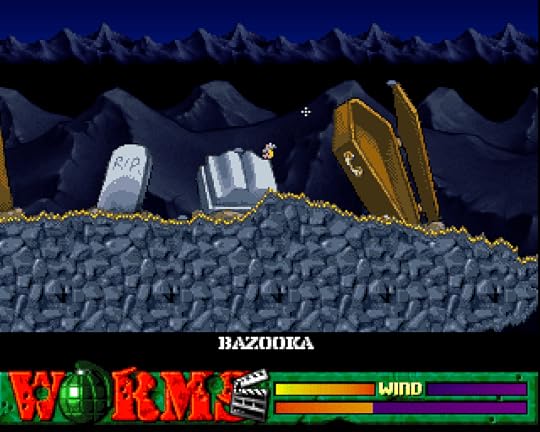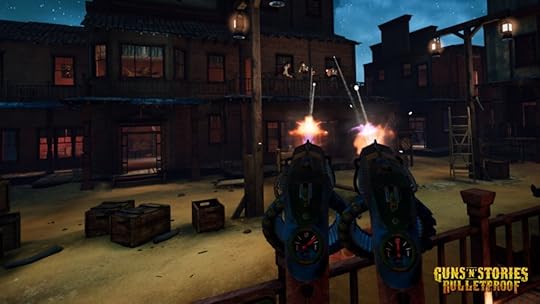Bill Loguidice's Blog, page 23
January 14, 2022
HTC Vive/VIVEPORT VR Review: Manastorm: Champions of G’nar
This review was originally created in July 2018 for HTC, targeted to their Vive/Vive Pro (VIVEPORT). It is reproduced here without alteration.
Not since Sony’s The Eye of Judgment (2007) for the PlayStation 3 have we had a major turn-based card battle video game attempt to take advantage of some type of advanced mixed reality technology. While that game utilized the PlayStation Eye camera paired with physical cards and a game board for a TV-based augmented reality experience, Manastorm: Champions of G’nar makes use of the HTC Vive‘s advanced virtual reality technology to offer a far more immersive, and completely self-contained, card battle video game.
Manastorm: Champions of G’nar‘s premise is simple. In the realm of G’nar, you are a spell casting, minion summoning, magic card playing, and bow-wielding wizard. Equipped with an enchanted deck of cards, you step into battle and fight to become the Champion of G’nar. Besides cards, there are dice, sand timers, crafting elements, and other components that you’d find in a typical card or board game of this type, as well as some unusual items like a bow and arrow.
Despite being a card game, this is primarily a standing, room-scale experience. However, with warping, you should have no problem playing even in smaller rooms. Otherwise, you’ll need to walk between different tables or sections in your laboratory or battle station. Both HTC Vive controllers, which are virtually represented in-game, are used to control the action.
 The germ of a full game experience is here.
The germ of a full game experience is here.Unfortunately, the game that’s available now is not the game the developers have planned for the future. For one, there’s no multiplayer, so this is strictly a single-player versus the computer game, with a fairly rudimentary artificial intelligence. While the graphics that are in place look good, they’re targeted for improvement, as is the expansion of the limited number of sound effects. Crafting, which is meant as a way to buff, or increase the power of an object through physical effort, is also missing, although the function is present on a purely cosmetic basis prior to starting a match.
So what is present? Right now, there’s just a fixed 20 card deck with no ability to customize or pick the cards for your particular play style. There’s also just a single battle to repeat. It says a lot, however, that despite the present limitations, what’s there is fun, at least for a playthrough or two. There’s definitely a solid core here for the developers to expand from.
If you’re a fan of card battle games, digital or otherwise, like Magic: the Gathering, Hearthstone, or Yu-Gi-Oh!, you’ll likely be disappointed with how limited Manastorm: Champions of G’nar is in comparison to these genre stalwarts. For card-battling veterans, this game will likely do little more than satisfy a curiosity with how well the concept can be translated to virtual reality. On the other hand, for newcomers to the concept, Manastorm: Champions of G’nar‘s limitations can serve as a gentle introduction to card battle games. Sadly, though, with just a single battle scenario and little else to do at this time, even newcomers will likely lose interest after a handful of playthroughs.
Score: 2 out of 5 stars.
Manastorm: Champions of G’nar is available on Viveport or with a Viveport Subscription.
The post HTC Vive/VIVEPORT VR Review: Manastorm: Champions of G’nar appeared first on Armchair Arcade.
January 4, 2022
HTC Vive/VIVEPORT VR Review: Kitty Rescue VR
This review was originally created in August 2018 for HTC, targeted to their Vive/Vive Pro (VIVEPORT). It is reproduced here without alteration.
ThoughtCatalog has described cats as the “unofficial mascot of the Internet.” Although a seemingly outrageous statement, if anything, this declaration doesn’t give the importance of cats in popular culture enough credit. It’s no surprise then that cats are a regular subject for virtual reality experiences. Kitty Rescue VR is one such experience, with not only much to enjoy for cat lovers, but also a little something that might even please cat haters.
The premise of Kitty Rescue VR is simple. The cat, conveniently named “Kitty,” is always getting herself into trouble. It’s up to you to defy the odds and rescue Kitty from ridiculously high places.

While some virtual reality experiences try for longer play sessions, Kitty Rescue VR focuses instead on short and punchy, with the whole game broken up into three scenarios and a bonus level, taking just 5 to 10 minutes or so to complete. The three scenarios are: Window Washer, Walk The Crane, and Girder Jump.
In Window Washer, Kitty has walked onto a window washing rig that was closed for repair and is now swinging about 200 feet in the air. In Walk the Crane, Kitty wanders onto a rickety old plank at the top of a crane. And in Girder Jump, Kitty had fallen asleep on some girders and woke to find herself trapped high up on a ledge.
Each scenario builds up in intensity from the last, with Window Washer tasking you with reaching out across a void to rescue Kitty, Walk the Crane tasking you with walking across a plank and grabbing Kitty, and Girder Jump requiring you to jump from crane-to-crane, and back, to return Kitty to safety. If you have a fear of heights, this will definitely play to that, but the thoughtful scenario progression can also help you overcome it, at least within virtual reality.
Once you complete all three scenarios, the Bonus Skill Level unlocks. To play, at the scenario selection screen, you grab Kitty to begin. Targets appear and you then have to try and throw Kitty at each target in a race against the clock. Although like in the main scenarios there’s never any violence depicted – Kitty vanishes whether you miss or hit a target – it can still be cathartic to give Kitty a hearty toss if cats really aren’t your thing.
As you might expect for this type of game, Kitty Rescue VR is played standing, preferably in a larger room-scale setup because of the walking requirement in the various scenarios. Of course, you have to be careful not to walk in the wrong spot and fall down, ending your game. Each Vive controller represents a hand and is used both for grabbing Kitty in the scenarios and tossing Kitty in the bonus level. If you accidentally release the trigger when holding Kitty in the main scenarios, the cat will fall, also ending your game.
 The visuals are serviceable.
The visuals are serviceable.Visually, Kitty Rescue VR has a clean, clear look, with a nice mix of realistic and more cartoon-like graphics. There’s also a convincing sense of height when trying to rescue Kitty. The animation is OK, but Kitty herself is rather stiff and robotic. Music and sound effects, including Kitty’s meows, suit the overall theme.
Although Kitty Rescue VR errs on the shorter side and only features three scenarios and a bonus level, what’s there is definitely fun. It’s just a shame that this excellent foundation is not further enhanced with additional whacky scenarios to rescue the hapless Kitty from.
Score: 3 out of 5 stars.
Kitty Rescue VR is available on Viveport or with a Viveport Subscription.
The post HTC Vive/VIVEPORT VR Review: Kitty Rescue VR appeared first on Armchair Arcade.
December 29, 2021
Amiga 500 Mini – All 25 Licensed Games Included
THEA500® Mini game list has been announced. While you can easily add your own games through the famous WHDLoad method, it’s always nice to have onboard, licensed games that are good representatives of the platform in question.
THEA500 Mini is styled after the most popular Commodore Amiga model, the 500, and is similar to the THEC64 Mini (Commodore 64 or C-64-inspired) in that it’s a compact plug and play console and not a more fuller-featured version of the original Amiga computers, although you can add your own USB keyboard. Of course, the same company also released the full-size version of THEC64 with a real working keyboard, so we definitely anticipate the same thing happening on the Amiga side of the equation at some point, which will be great even for those us who still maintain original hardware.
Here’s the list of 25 included games on THEA500 Mini along with links to each of the MobyGames entries for your reference:
Alien Breed 3DAlien Breed: Special Edition 92Another World (aka, Out of this World)Arcade PoolATR: All Terrain RacingBattle ChessCadaverCalifornia GamesDragons Breath (aka, Dragon Lord)F-16 Combat PilotKick Off 2Paradroid 90Pinball DreamsProject-X: Special Edition 93QwakSimon the SorcererSpeedball 2: Brutal DeluxeStunt Car Racer (aka, Stunt Track Racer)Super Cars IIThe Chaos Engine (aka, Soldiers of Fortune)The Lost Patrol (aka, Lost Patrol)The Sentinel (aka, The Sentry)Titus the Fox (aka, Titus the Fox: To Marrakech and Back)Worms: The Director’s CutZool: Ninja Of The ”Nth” Dimension (aka, Zool) Worms: The Director’s Cut, just one of many legendary games built-in.
Worms: The Director’s Cut, just one of many legendary games built-in.The post Amiga 500 Mini – All 25 Licensed Games Included appeared first on Armchair Arcade.
December 23, 2021
HTC Vive/VIVEPORT VR Review: Host
This review was originally created in November 2018 for HTC, targeted to their Vive/Vive Pro (VIVEPORT). It is reproduced here without alteration.
Although there have been some excellent virtual reality escape room experiences, few have had ambitions beyond supersizing what can be experienced in a traditional physical adventure game setting. Host, on the other hand, takes the proven escape room concept and transports it into a mobile, otherworldly experience.
The premise is that your spacecraft crashes on an unknown planet. You need to navigate through the dark, alien corridors, using only your hands to solve the rooms and eventually make your way out.
Host supports Vive, Vive Pro, or Oculus Rift owners and is a standing, room-scale experience. And unlike many other room-scale experiences, this game really means it. There’s no other way to move within the game other than walking around your own room.
Unfortunately, Host‘s room-scale requirements are a bit steep. There’s a recommended play space of 3 x 2 meters, or about 10 x 6.5 feet. While you might be able to play in a smaller room, you may have trouble reaching some of the in-game areas you’ll need to access to advance. And because you’re literally walking around small, winding corridors in-game, there’s a good chance you’ll be bumping into your real world, in-room objects or walls. And of course, if you have your Chaperone settings turned on like I do – and probably need anyway for this type of game – you’ll be seeing way too much of the collision boundaries, hurting immersion.
 The visuals are unique, but not necessarily that impressive.
The visuals are unique, but not necessarily that impressive.While Host makes use of both Vive controllers, it’s merely to keep track of your hands. The in-game representation of your hands are permanently open and floating in space until you get near a touchable object. The virtual hand’s index finger then turns into a pointer. Otherwise, as stated, the rest of the game involves you physically walking around corridors and ducking into portals and other openings.
Audio-visually, there’s not much to the game, with sparse sound effects and graphically simple environments. Since it’s a dark, alien world, with a type of bioluminescent glowing effect to the surroundings and creatures, it’s still pretty effective at setting an otherworldly, and sometimes scary, mood. However, this is strictly about navigation and light puzzle solving, so there’s no actual danger of being attacked in-game. Surprisingly, knowing that doesn’t seem to lessen the tension when an alien creature gets in your face.
Outside of Host‘s use of true room-scale gameplay, there’s nothing else particularly engaging about the total experience, which lasts around 30 minutes or less. While you do feel like you’re walking around alien corridors, there’s not much to do, and, unless you have a particularly large room, it’s all too easy to break immersion or become frustrated by bumping into walls or seeing the Chaperone boundaries. Hopefully the developers can try again with a different project that refines this promising concept into something that works better in smaller spaces and has more compelling gameplay.
Score: 2 out of 5 stars.
Host is available on Viveport or with a Viveport Subscription.
The post HTC Vive/VIVEPORT VR Review: Host appeared first on Armchair Arcade.
December 21, 2021
Review: Gaimglass FPS Aim Assist for PC and Console Games
Although there are ways to tweak the targeting cursor and other visual cues in many First Person Shooter (FPS) games – and even monitors that offer a variety of crosshair overlays as options in their menus – Gaimglass has taken a decidedly physical approach to the problem. Using a CNC-cut clear acrylic aim plate that goes on your monitor and an LED-powered 1.0mm aimpoint, Gaimglass promises increased accuracy for just about any game that uses an always centered crosshair. But does it really work?
 What you get.
What you get.Gaimglass claims compatibility with up to 27 inch 16:9 monitors, 34 inch 21:9 monitors, and 49″ 32:9 monitors. I’m testing it on an LG 34 inch 21:9 monitor.
Setup is simple following the instructions at https://gaimglass.com/start. Slide the metal holder up the aim plate until you reach the top, set it on top of the monitor, add the thumb screw, plug in the included microUSB power cable, turn on the power switch, calibrate by lining up the target, and then tighten the thumb screw to keep it in place.
 Calibration is pretty easy, but it is of course a manual process.
Calibration is pretty easy, but it is of course a manual process.An annoyance of course is that since you have to place the Gaimglass from the top center of the monitor, those of us with a webcam (or something else) there have to move it. On my primary desktop, my webcam is secured in place, so I can’t easily move it, which is why I had to test on one of my secondary systems. The USB power cable is also an annoyance, particularly since this is the type of device that could easily be battery powered.
 It’s hard to convey in live photos, but it worked great in Fortnite.
It’s hard to convey in live photos, but it worked great in Fortnite.I fired up the game I’ve put the most hours into all-time, and that’s Fortnite. The crazy thing is is that bright green dot really does help you focus exactly dead center and certainly has the potential to up your hit (and kill) counts. While it’s not something I could see using long-term because it is a bit obtrusive (although outside of the dot it does eventually blend in when playing), as well as a bit annoying to take on and off the monitor when not FPS gaming, it does accomplish what it states.
While not a perfect or even particularly elegant solution, the Gaimglass works and could definitely make a good accessory for an FPS enthusiast. Goodness knows gamers have wasted money on far less useful things.
The post Review: Gaimglass FPS Aim Assist for PC and Console Games appeared first on Armchair Arcade.
December 14, 2021
HTC Vive/VIVEPORT VR Review: Homebound
This review was originally created in October 2018 for HTC, targeted to their Vive/Vive Pro (VIVEPORT). It is reproduced here without alteration.
The 2013 film, Gravity, starring Sandra Bullock and George Clooney, was a convincing dramatization of how a near future low Earth orbit space disaster might unfold. By focusing on how the astronauts dealt with each increasingly dramatic event, the filmmakers brought a welcome personal touch to a movie that could have credibly stood on the magic of its special effects, and use of 3D, alone.
The much earlier 1968 film, 2001: A Space Odyssey, on the other hand, while having similarly impressive special effects relative to its era, had a more epic, sweeping story, dealing with themes of existentialism, human evolution, technology, the possibility of extraterrestrial life, and artificial intelligence (AI) along the way. It’s perhaps this latter theme that the film is most known for, where a rogue AI, HAL 9000, makes life unbearable for those onboard the spacecraft, Discovery One, which is bound for Jupiter.
By taking inspiration from both of these iconic films, Homebound has big shoes to fill. The game takes the overcoming-a-series-of-disasters theme from Gravity and mashes it up with the AI “companion” theme from 2001: A Space Odyssey. As a way to make these themes more its own, Homebound introduces something that was mostly missing from those films, touches of humor, including a much-appreciated The Simpsons reference.
Designed as a seated or standing experience, you use both Vive controllers to navigate through the three different set pieces, or levels: Deep Space, Earth’s Atmosphere, and Earth. Each level takes about 10 minutes of play time, for a total of around 30 minutes of total gameplay. There are also time attack and free roam modes. In time attack, you try to beat your personal best time or challenge the best times of others. In free roam mode, you can explore the environments at your own pace.
 Lots of style over substance.
Lots of style over substance.Homebound definitely proves more experience than game. There are limited opportunities for interaction, including trying to orient yourself correctly, pushing some buttons, and moving some levers. Fortunately, as an experience, Homebound proves attractive. The visuals, save for a few disappointing textures here and there, are downright beautiful. Of course, you’ll need a fairly powerful computer to experience this game at its highest fidelity.
Unfortunately, it’s not the visuals, level of interactivity, its inspirations, humorous touches, or anything else that really defines Homebound as much as its potential for motion sickness. Floating in space, the general jerkiness of just looking around, etc., simply don’t lend themselves well to the general disconnect with what your body is doing in the real world. As such, If you’re at all prone to virtual reality motion sickness, steer clear of this one. I know I had my ginger candies working overtime for this one, even when I just stuck to playing individual 10-minute sections.
Ultimately, while Homebound does a great job of bringing the hands-off experience of watching Gravity to the more immersive potential of virtual reality, the concessions made along the way make it a difficult recommendation. Controls can be imprecise and the disconnect between what you’re doing in-game and what your body is doing in the real world can be brutal on the stomach. If you can tolerate the motion sickness and treat this mostly as a slightly more interactive short film, you may still find value here, particularly since the visuals are genuine stand-outs. For everyone else, the price to pay for experiencing this eye candy might be a bit too much.
Score: 2 out of 5 stars.
Homebound is available on Viveport or with a Viveport Subscription.
The post HTC Vive/VIVEPORT VR Review: Homebound appeared first on Armchair Arcade.
December 7, 2021
HTC Vive/VIVEPORT VR Review – Guns’n’Stories: Bulletproof VR
This review was originally created in October 2018 for HTC, targeted to their Vive/Vive Pro (VIVEPORT). It is reproduced here without alteration.
First person wave shooters are among the most common gaming genres in virtual reality. This take on old-fashioned shooting galleries commonly features many different types of weapons, various defensive capabilities like ducking and dodging, and a limited player movement area as waves of typically fast-moving enemies intent on your demise emerge from on- and off-screen locations. It’s a straightforward concept to implement and works particularly well when paired with virtual reality’s inherent immersive properties.
Unfortunately for developers, since we see this the type of game so much, whenever there’s another release in this genre, our expectations are sky-high. And rightly so. If a first person wave shooter isn’t up-to-snuff, and in fact doesn’t elevate itself well above the average, we may as well just play one of the other countless options that are available. That’s the challenge that Guns’n’Stories: Bulletproof VR is up against.
In the game, you take on the role of Grandpa Bill, regaling his grandson Robbie with wild tales from his younger days. In the stories, Grandpa Bill is a legendary cowboy who uses increasingly powerful and fantastic weapons as he battles countless enemies on his way to ultimately rescue his beloved Charlotte in a Hollywood-style Wild West. Your job is to play the young Grandpa Bill as the stories are set up and unfold, all while keeping Robbie’s skepticism in check. It’s a great conceit for what might otherwise be just another action-packed shooter and helps to set up a lot of the game’s cheeky humor, as well as helping to give each of the three acts more purpose, meaning, and interest.
 The gameplay is surprisingly engaging for the genre.
The gameplay is surprisingly engaging for the genre.While the fun backdrop might be enough on its own to keep you playing to advance the story, the gameplay is fortunately just as engaging. Although it’s still just a first person wave shooter at its core, the variety of weapons, defensive actions, and precise control put it at the top of its genre in those areas. A variety of modes and difficulty levels doesn’t hurt either.
Designed for Vive, Vive Pro, or Oculus Rift, Guns’n’Stories: Bulletproof VR can be played standing or seated in just about any size room. The Vive controllers are used to dual-wield various weapons, which are used not only to take out enemies, but also to shoot at and bat away projectiles. Combined with the usual ducking and dodging, this game can be quite the multi-tasking workout, particularly in the later stages of the game and when playing on the higher difficulty levels.
Like the well-written, humorous story that book-ends the three levels and boss fights, and the excellent controls, the audio-visuals are also top-notch. Detailed environments, stylized character models, and smooth action all come together with strong sound design.
Did we really need another first person wave shooter? Prior to Guns’n’Stories: Bulletproof VR, I might have said no. Fortunately, this game proves there’s still plenty of life left in the genre. When a game like this features such high production values and clearly pays real attention to what makes a game in this genre great, it’s proof you can still beat the odds and stand out.
Score: 5 out of 5 stars.
Guns’n’Stories: Bulletproof VR is available on Viveport or with a Viveport Subscription.
The post HTC Vive/VIVEPORT VR Review – Guns’n’Stories: Bulletproof VR appeared first on Armchair Arcade.
December 3, 2021
HTC Vive/VIVEPORT VR Review: Gates of Nowhere
This review was originally created in October 2018 for HTC, targeted to their Vive/Vive Pro (VIVEPORT). It is reproduced here without alteration.
Dungeon crawlers are among the most durable video game genres, dating back to the earliest days of the industry and attempts to computerize a Dungeons & Dragons-style pen and paper role-playing experience. As with many other genres, virtual reality can take the dungeon crawling video game experience to the next level, with an incredible sense of immersion that simply isn’t possible any other way.
Gates of Nowhere is described as a fantasy horror adventure. You play as a Seeker, Lother, who is looking for the lost knowledge of the Alchemists in a deep, dark dungeon, filled with monsters. As is typical for the genre, you start out inside an empty prison within a dungeon and then must fight your way out to survive, solving puzzles, crafting potions, and making smart use of whatever weapons and other items you find along the way.
There are four levels: The Awakening, Through the Dark, Waterworks, and Inferno, with a total play time of around six hours or so. There’s also a tutorial room, which precedes The Awakening, and can also be started on its own. In the tutorial, you learn how to pick up and drop objects, use a sword, long bow, and crossbow, and craft a potion from various types of ingredients.
Since you need access to so much within the game environment, this is strictly a standing, room-scale experience, with the more space you have to maneuver in, the better. Designed for the Vive, Vive Pro, or Oculus Rift, the game makes quite a bit of use of all of the buttons and features of both of your Vive or Oculus Touch controllers. Even though the control layout is fairly logical, with so much to do, it definitely takes some time to become familiar with everything, including, for instance, the cadence required to double-click a side button on the Vive controller to drop what you’re holding in that hand.
In-game movement is a choice between real-time grid-based movement using the Vive controller’s trackpad, or teleportation. Both choices have their challenges. With the grid-based movement, there’s a big disconnect between your onscreen actions and what your body is doing in reality, so this can lead to motion sickness. With the teleportation-based movement, unlike the way it’s typically implemented in other games, there’s an extra step involved after selecting your destination. While the reality is is that for this type of game, grid-based movement really is a requirement to more precisely get to where you want to, or need to, go, unless you’re particularly resistant to motion sickness, you’ll be better off using some combination of the two methods.
 Ranged weapons are also an option.
Ranged weapons are also an option.Sword fighting and use of ranged weapons are a lot of fun, although I would have liked a bit more precision from both. This lack of precision can also manifest itself in frustration with some of the other actions, like trying to turn a key in a door. The requirement to mix various elements into potions by following recipes adds some much-needed depth to what would otherwise be a more straightforward dungeon crawling experience.
Visually, the game is quite striking, with particularly detailed environments. The dark motif provides a great excuse for creepy lighting effects and quite a few jump scares. I know my heart was racing even in the beginning of the game as various skeleton warriors descended upon my position. The sound design also does a good job of complementing the setting.
Gates of Nowhere proves a nice change of pace from the typical sci-fi-heavy or cartoon-like experiences found in many other virtual reality games. Despite some control issues, the game definitely comes together as a fun, deep, and ultimately satisfying, experience.
Score: 4 out of 5 stars.
Gates of Nowhere is available on Viveport or with a Viveport Subscription.
The post HTC Vive/VIVEPORT VR Review: Gates of Nowhere appeared first on Armchair Arcade.
November 30, 2021
HTC Vive/VIVEPORT VR Review: Furious Seas
This review was originally created in November 2018 for HTC, targeted to their Vive/Vive Pro (VIVEPORT). It is reproduced here without alteration.
Although piracy, or buccaneering, has a mostly negative historical reality, that hasn’t stopped the subject from becoming a pop culture staple. Whatever the realities, there’s just something romantic and exciting about the concept of sailing the high seas in search of fame and fortune. Fortunately, simulating arguably the more compelling parts of the pirate experience – sailing and battling other ships – is definitely a natural for virtual reality.
Furious Seas casts you as a pirate captain during the Age of Sail. You battle other pirate ships until you eventually collect a bounty by defeating a boss, which is your ultimate goal for any particular level. There’s also an Exploration Mode you can unlock, where you can explore the seas at will and cause general mayhem without a specific goal in mind.
The game is designed for Vive, Vive Pro, or Oculus Rift owners as a seated or standing room-scale experience. Unlike many other virtual reality games that have seated play as a bullet point, Furious Seas works just as well when playing seated as it does standing. With that said, I still found it a lot more fun to command my ship standing.
The control scheme is a little unusual. Both controllers, which represent your in-game hands, do the same thing. You use the side Grip buttons to grab objects, be it the steering wheel, bell rope, or cannon, and the Trigger to fire a cannon. While this makes cannon fire quick and easy once in position, using the Grip button to grab things proves a bit uncomfortable, particularly in the heat of action.
 All controls are within easy reach.
All controls are within easy reach.Since everything you need to control is within easy reach, there’s no need for any type of movement or warp functionality. To your left and right are cannons, which you can grab and move, as well as shoot. In front of you is the wheel. To the upper right of the wheel is a bell you can ring to raise the sails and go full speed. To the left is a bell to drop the sails and stop the ship.
Even though the small, vocal crew in front of you doesn’t necessarily do much other than cycle through some simple animations, it’s still a refreshing change to actually have a team with you, as other games of this type tend to portray buccaneering as a solo affair. In fact, the crew is a bit more than window dressing and become part of the strategy as you try and maneuver your ship in a prime position. If you position your ship just right and an enemy ship is in range, the crew will use their own cannons to increase your firepower. About the only limitation is that the crew’s cannons reload much slower than your own.
Visually, the game looks spectacular, with well-modeled in-game objects and environments, as well as incredible water effects. Surprisingly, even with the constant ship motion, undulating seas, and my weak stomach, I felt no motion sickness, something the developers proudly advertise as something they’ve eliminated.
Audio is similarly well-done, with excellent water sounds and suitable effects for in-game objects, like the cannon. Fun sound design and chatter for the crew and bosses round out the audio experience.
Furious Seas succeeds on almost every level. Although not yet considered the full, final release candidate, what’s there is still lots of fun, with a surprising amount of strategic depth. It’s the best way yet to get a taste of the pirate life in virtual reality.
Score: 5 out of 5 stars.
Furious Seas is available on Viveport or with a Viveport Subscription.
The post HTC Vive/VIVEPORT VR Review: Furious Seas appeared first on Armchair Arcade.
November 24, 2021
HTC Vive/VIVEPORT VR Review: Fruit Ninja VR
This review was originally created in September 2018 for HTC, targeted to their Vive/Vive Pro (VIVEPORT). It is reproduced here without alteration.
When it was first released back in 2010, Fruit Ninja took the mobile gaming world by storm. From there, it received ports to various other platforms, including Microsoft’s Xbox 360 console with Kinect, and even the arcade.
In most versions of the game, players use a touchscreen to slice and splatter fruit, all while avoiding bombs, which are explosive to touch. In the Xbox 360 version, Fruit Ninja Kinect, the Kinect peripheral’s cameras make your arms the blades. While all of these previous Fruit Ninja experiences were an undeniable blast to play, there was always a certain sense of immersion lacking. Fortunately, Fruit Ninja VR takes the lessons learned from these past versions of the game and uses the unparalleled immersive possibilities of virtual reality to create the ultimate Fruit Ninja experience.
Each Vive controller represents a katana (sword), whose blade you use to slice, juggle, and skewer various types of fruit, including watermelons, pineapples, and oranges. The more fruit you can hit at once, the better your combo bonus. Naturally, you also need to deflect or avoid any bombs.
There are four different modes to choose from: Arcade, Classic, Zen, and Survival. In Arcade Mode, you have to slice as much fruit as you can in 60 seconds, using big combos and special bananas to rack up huge scores. In Classic Mode, it’s the original Fruit Ninja experience with simple fruit slicing and bomb avoiding fun. In Zen Mode, which doubles as a practice mode, you have 90 seconds to slice as much fruit as you want with no need to worry about bombs. In Survival Mode, the difficulty is ramped up as you face off against flying cannons, and, just like in Classic mode, three strikes (misses) and you’re out.
As you would expect for this type of game, it’s best played standing in a room-scale environment. You’ll only need enough space to comfortably move your arms and controllers in a roughly 180 degree arc in front of you, but of course you’ll also occasionally be raising your arms above you when the action gets heated, so for those with low ceilings, consider this your warning. Most modes also make great workouts.
 It’s a pleasing looking game.
It’s a pleasing looking game.Audio-visually, Fruit Ninja VR is on point. The same type of satisfying music and sound effects from the other versions of the game complement the bright, cell-shaded graphics. Every object, be it the flying fruit or the buildings in the environment, is well-rendered and easy to identify.
If this were the first release of the game, Fruit Ninja VR would have likely caused the same type of sensation it did when it debuted on mobile devices all those years ago. As it is, some of Fruit Ninja‘s potential impact is a bit muted by the fact that we’re already about a dozen platforms in.
Despite its familiarity, Fruit Ninja VR proves a sublime virtual reality experience, creating the best and most immersive version of the game to date. With its proven, short-form gameplay paired with an excellent physics model, super responsive motion tracking, and polished audio-visuals, Fruit Ninja VR is the type of game that can please virtual reality enthusiasts of every stripe.
Score: 5 out of 5 stars.
Fruit Ninja VR is available on Viveport or with a Viveport Subscription.
The post HTC Vive/VIVEPORT VR Review: Fruit Ninja VR appeared first on Armchair Arcade.



